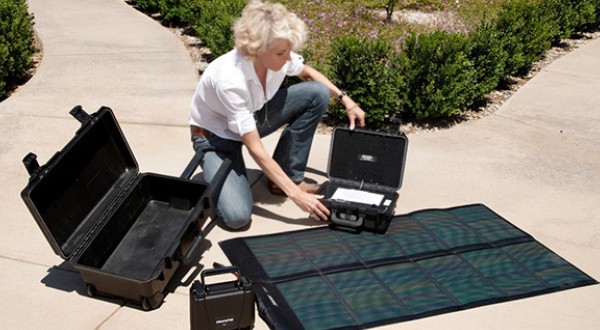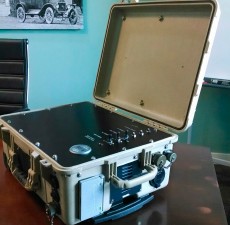
Ojai Energy Systems CEO and President Catherine Von Burg with some of the Ojai company’s portable battery systems.
TECHNOLOGY | August 1-7, 2014
By By Stephen Nellis
Staff Writer
An Ojai company’s creation that started as a way to run camera and lighting gear for on-location film shoots has evolved into a battery system that can power everything from military forces in Afghanistan to an off-grid organic vodka distillery in Hawaii.
Ojai Energy Systems, or OES for short, just moved into a new space on Bryant Circle to accommodate its booming production. At the facility, OES takes raw cells and its proprietary power electronics designs and manufactures complete power systems.
At roughly the size of an iPad, the Baby Genny can draw in power from any source — wind, solar, house current, even a car battery — to power small devices. The Big Genny provides more power but at the size of a carry-on luggage item.
At the larger end, the company’s battery systems power monitoring stations in the Owens Valley for the Los Angeles Department of Water and Power and have been used along with foldable solar panels and small wind turbines to provide portable power for troops. A Whole Foods Market store in Folsom runs its signage off solar while the store pulls from the grid. And at Ocean Vodka in Hawaii, the batteries work along with solar panels to provide uninterrupted off-grid power.
But the idea got its start in 2002, with a product called the LibertyPak. Stu Lennox, an art director in the film industry, had seen lithium ion batterers on e-bikes. He started developing belts of batteries that could power digital and film photography gear while on remote locations where noisy, polluting generators would be infeasible.
The products sold well to the film industry, but Lennox saw other applications. In 2010, OES was born to take the technology to a variety of different markets. Along the way, Lennox had switched away from lithium ion technology and to lithium iron phosphate chemistry. That eliminates one of the risks that have plagued lithium ion batteries in everything from laptops to cars — thermal runaway, otherwise known as randomly bursting into flames.

An OES battery system can draw in power from any source — wind, solar, house current, even a car battery — to power small electronic devices.
Catherine Von Burg, who now heads OES while Lennox remains its technology chief, said the tradeoff with lithium ferrous phosphate batteries is that they have slightly less power density but far better durability.
“If we had a pound of material, the lithium cobalt ion would give you 100 watts, but it’s only going to last 500 to 600 cycles. With our chemistry, for that pound you’re going to get 75 to 80 watts but it’s going to last 2,500 to 5,000 cycles,” Von Burg said. “We warranty our residential OES 2 and OES 3 products for 10 years. Even though it’s a little less dense and you have a little larger battery for the same watts, they’re going to last exponentially longer.”
Another advantage of chemistry OES uses is that it isn’t sensitive to temperature changes the way that lead acid batteries are and doesn’t need ventilation. “We can pack a megawatt into a 20-foot shipping container, without cooling or ventilation,” Von Burg said.
The batteries also don’t need maintenance. The system produced for the L.A. water authority powers remote environmental monitors. “That’s a fiberglass box sitting in the middle of nowhere with ambient temperatures from 20 to 120 degrees,” Von Burg said.
In the next few years, OES is hoping to push into the residential and commercial battery markets. There’s currently tension between utility companies and homeowners over homeowners who zero out their bills or even generate more power than they use. OES is hoping that batteries could smooth out power from solar systems to make it more feasible for distributed power to become a significant portion of the power supply, possibly eliminating the need for new peaker plants. “If you can augment the grid infrastructure with distributed power, it makes it so much more effective and resilient,” Von Burg said.
In the larger scheme of things, OES aims to helps empower the disenfranchised around the world by literally empowering them with portable energy systems that can capture and store energy in the absence of centralized infrastructure.
OES is on a mission to “create power independence for people above and beyond centralized delivery systems,” Von Burg said. “People literally become empowered to farm, to have schools, to have clinics, to have resources that start with power.”


